How to confidently set your community pricing strategy
"How much should I charge?"
This seemingly simple question is, in fact, a complex puzzle that can make or break your community's success. As Tom Ross, founder of Learn Community and Circle expert, often emphasizes, many community builders struggle with confidently choosing the right price point for their community.
That’s why we put together this comprehensive guide, so you can:
- Understand the 7 critical pricing considerations
- Explore different pricing models and their pros/cons
- Learn how to avoid common pricing pitfalls
- Discover strategies for future-proofing your pricing
Whether you're just starting out or looking to refine your existing pricing model, this guide will provide you with the insights you need to make informed decisions about your community pricing strategy.
Understanding community pricing dynamics
Before we get into specific strategies, it's essential to recognize a fundamental truth about community pricing: there's no one-size-fits-all approach.
Each community is unique, with its own set of factors influencing the ideal price point. These factors can include:
- Your industry and niche: Different industries have different norms when it comes to community pricing. For example, a community focused on personal finance might command higher prices than a hobby-based community.
- Target audience demographics and expectations: Consider the demographics of your ideal members. Are they professionals with high disposable income, or students on a budget? Understanding your audience's willingness and ability to pay is crucial in setting an appropriate price.
- Value proposition and unique selling points: What unique value does your community offer? The more unique and valuable your offering, the more you can potentially charge.
- Overall community goals and vision: Are you aiming for a large, diverse community, or a small, exclusive group of highly engaged members?
- Operational costs and desired profit margins: Don't forget to factor in the costs of running your community, including platform fees, content creation, community management, and your own time investment.
Understanding these dynamics is crucial because they form the foundation upon which you'll build your pricing strategy. Plus, it helps to remember that there’s so many different ways to monetize a community (other than just charging to be in it!)
7 pricing principles
Now that we've laid the groundwork, let's explore the seven key considerations that should guide your pricing decisions. These insights, drawn from Tom Ross's experience and industry best practices, will help you approach pricing with confidence and clarity.
1. Income requirements
Before you can price your community, you need to understand your own financial needs. Ask yourself:
- What percentage of your total income do you want the community to represent?
- How much do you need to earn from the community to make it worth your time and effort?
For example, if you're aiming for the community to be your primary source of income, you'll need to price it higher than if it's just a supplementary revenue stream. Create a detailed budget that includes all your expenses, both personal and community-related, to get a clear picture of your income requirements.
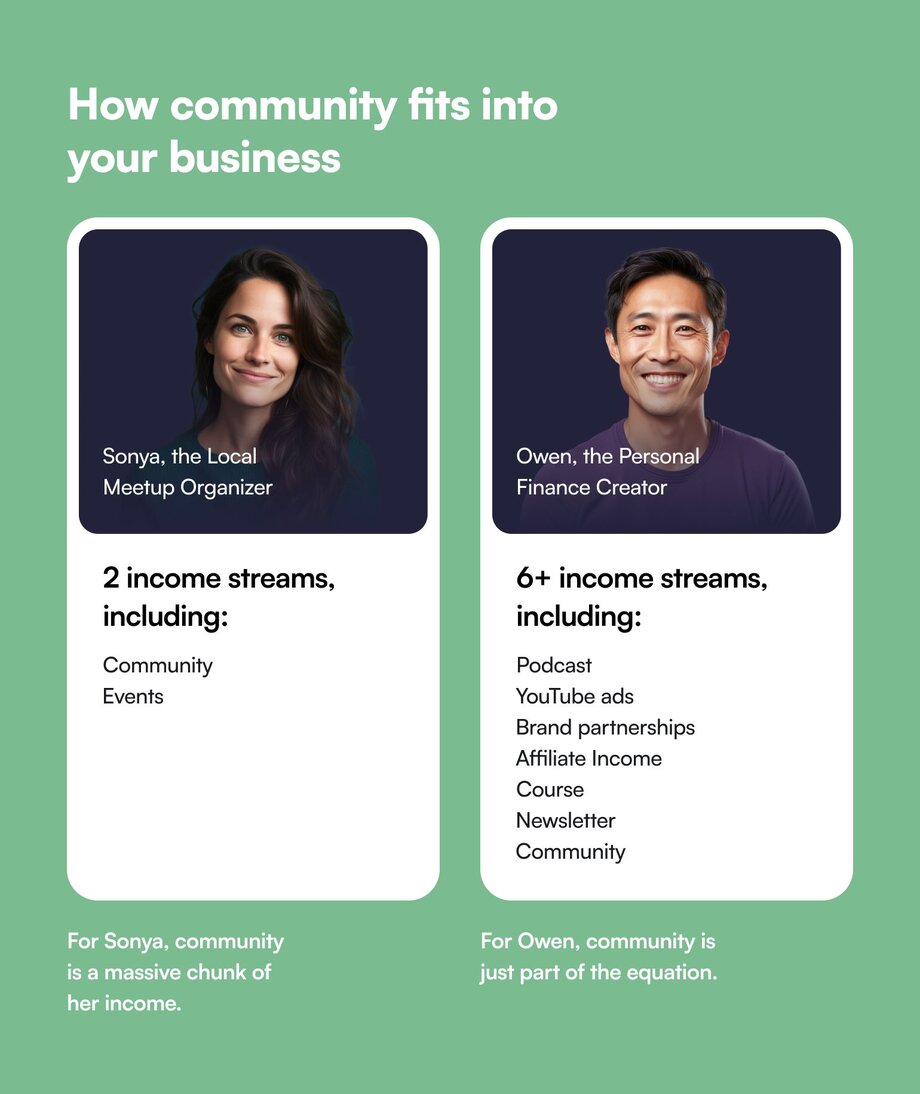
2. Industry standards
While your community is unique, it doesn't exist in a vacuum. Research typical price points for communities in your industry to understand the low and high end of the range. This research will give you a benchmark to work from and help you position your community effectively.
Methods for researching industry standards:
- Join similar communities as a member to experience their pricing firsthand
- Attend industry conferences and network with other community builders
- Analyze competitor websites and offerings
- Conduct surveys or interviews with your target audience to gauge their price expectations
Remember, the goal isn't to simply copy others, but to understand the landscape and make informed decisions.
3. Member ROI
One of the most critical factors in pricing is the return on investment (ROI) members will get from your community. The more tangible and valuable the results, the higher you can price your offering.
To evaluate member ROI:
- Identify specific, measurable outcomes members can expect (e.g., increased skills, networking opportunities, access to resources)
- Quantify these benefits where possible (e.g., "Members report an average 20% increase in productivity")
- Collect and showcase success stories and testimonials from existing members
- Create case studies that demonstrate the long-term value of community membership
By clearly articulating and quantifying the ROI, you not only justify your pricing but also make your community more attractive to potential members.
4. Community model
Your community model will significantly impact your pricing strategy. Are you aiming for:
- An intimate, high-touch experience with limited members and personalized attention?
- A larger scale, lower-priced community with more members but less individual interaction?
- Something in between, with tiered offerings for different levels of engagement?
Each model has its pros and cons:
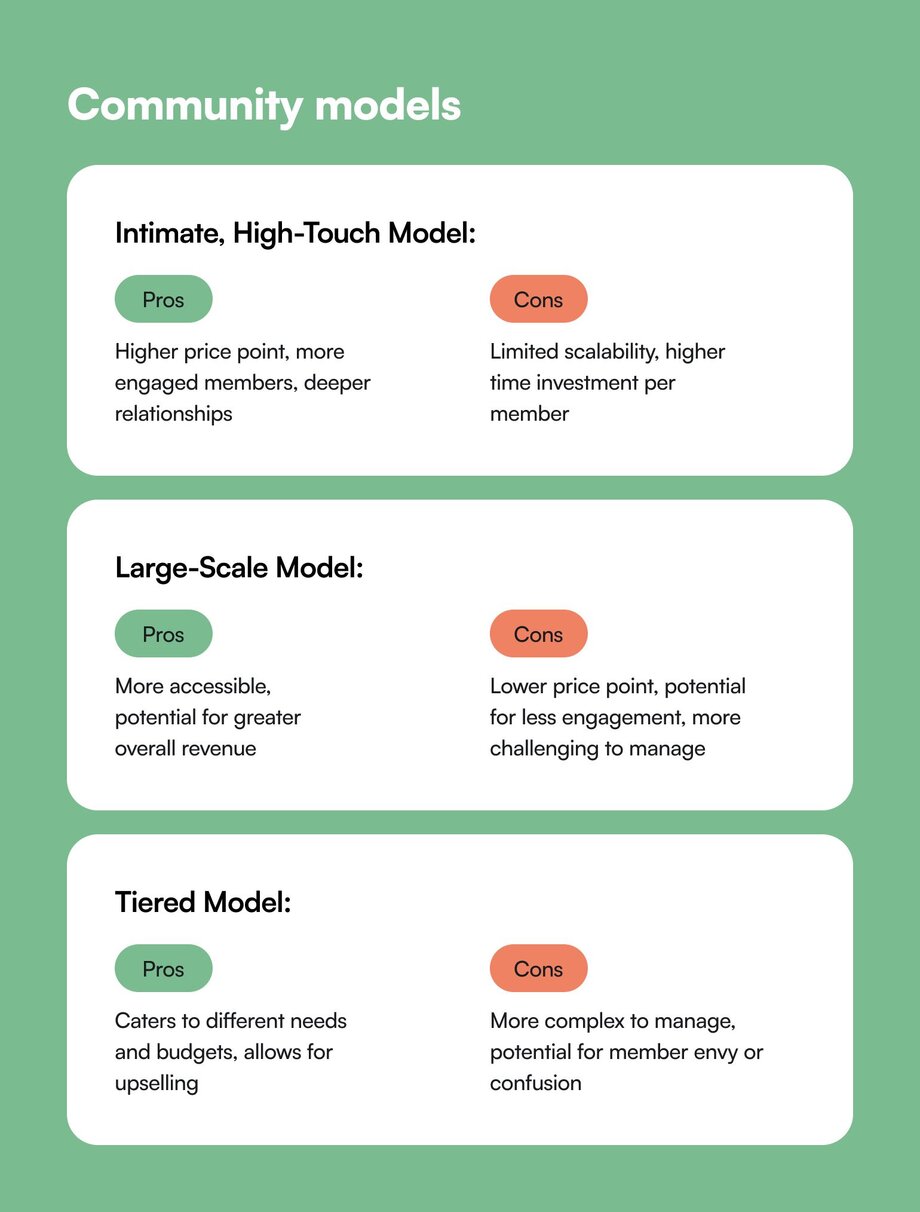
"I ran the numbers and realized that with just 1,000 members paying $100 a month, I could generate a million dollars a year. It was a lightbulb moment–I didn't need tens of thousands of members to create a successful community." - Tom Ross
The key is finding the balance between intimacy and scale that works for your specific community and goals.
5. Market positioning
Your pricing should reflect your position in the market. Assess what price you can realistically command based on:
- Your reputation in the field (and specific niche)
- Size and engagement of your existing audience
- Credibility (e.g., publications, speaking engagements, awards)
- Ability to drive demand and attract new members
Be honest in your self-assessment. If you're just starting out, you may need to price lower initially and increase as you build your reputation and prove your value. On the other hand, if you're a recognized expert in your field, don't undersell yourself – your expertise and reputation are what draws people to you.
6. Excitement factor
This aspect is subjective, but highlights the “art” part of choosing pricing:
Choose a price that gets you excited every time a new member joins. 🎉
This excitement indicates that you've found a good balance between the value you're providing and the compensation you're receiving.
“We could have provided half of what we do and still charged the same amount, and it would still be extremely valuable. You have to be thoughtful about where the value is.” - Erin Halper, Founder of The Upside
If you feel a twinge of regret or resentment when someone signs up at your current rate, it's a sign that you may be underpricing. But, if you feel guilty about your pricing, you might be charging too much.
7. Value proposition
Your value proposition is the cornerstone of your pricing strategy. It's not just about what you offer, but how you communicate it. A compelling value proposition should:
- Clearly articulate the unique benefits of your community
- Address specific pain points or aspirations of your target audience
- Differentiate you from other communities or alternatives
- Justify your pricing by demonstrating clear value
Spend time crafting and refining your value proposition. Test it with potential members and gather feedback. A strong value proposition can justify higher pricing and make your community more attractive to potential members.
Here’s an example from one of Circle’s communities, Diaspora Nutrition, which uses the community spaces on Circle to empower and connect their clients who are going through their nutrition program.

Value proposition example:
Diaspora Nutrition is designed to help Indian immigrants navigate the USA food market to support weight loss and health goals that honor Indian food heritage.
And here’s a breakdown of why that value proposition works:
-
Unique & differentiated:
- Culture-focused nutritional care: The website offers nutrition services tailored specifically for Indian immigrants (NRIs) living in the USA. The language used demonstrates a deep understanding of the audience's preferences and challenges.
-
Pain points they solve:
- Sustainable Indian diet planning: Instead of promoting trendy Western diets, they emphasize creating meal plans that incorporate traditional Indian foods and flavors.
- Addressing specific health concerns: Moving to the “west”, many NRIs face weight loss challenges and manage chronic health issues like diabetes, gut health, hypothyroidism, and PCOS.
-
Adding value:
- Navigating the US food market: Diaspora Nutrition guides clients on how to source and use local ingredients in the USA to create healthy Indian meals, bridging the gap between Indian cuisine and American food availability.
- Non-restrictive approach: Unlike typical diet plans that may involve calorie counting or eliminating food groups, they promote a more balanced and inclusive approach to healthy eating.
- Personalized support: The program offers personalized 1-on-1 nutrition support and a community of support.
- Long-term health focus: With a 12-month program, Diaspora Nutrition aims to help clients not just lose weight, but also add healthy years to their lives.
Exploring community pricing models
There are several pricing models to consider for your community:
Freemium model: the power of "free"
The freemium model involves offering a mix of free and paid tiers within your community. This approach can be powerful for attracting new members and showcasing your value.
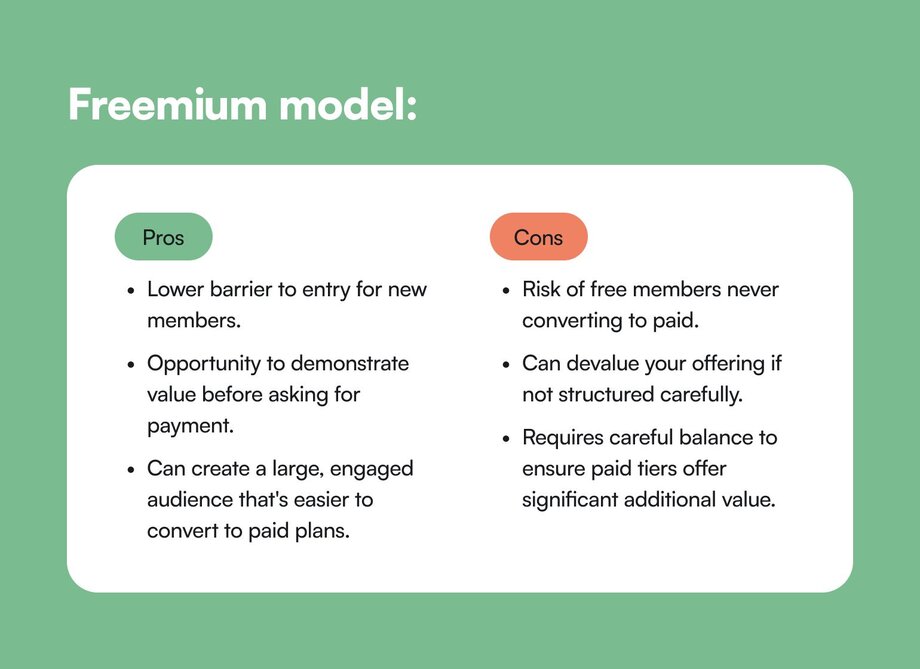
Implementation tips:
- Clearly define what's available in the free tier vs. paid tiers
- Use the free tier to showcase your expertise and community value
- Create strategies to regularly encourage free members to upgrade
Example: A digital marketing community might offer free access to a general discussion forum and basic resources, while reserving expert Q&A sessions, advanced tutorials, and networking events for paid members. Diaspora Nutrition from above has a freemium model that lets them engage and provide value to people before purchase!
Subscription-based pricing: steady income and member commitment
Subscription-based pricing is one of the most common models for online communities. It involves charging members a recurring fee (usually monthly or annually) for access to the community.
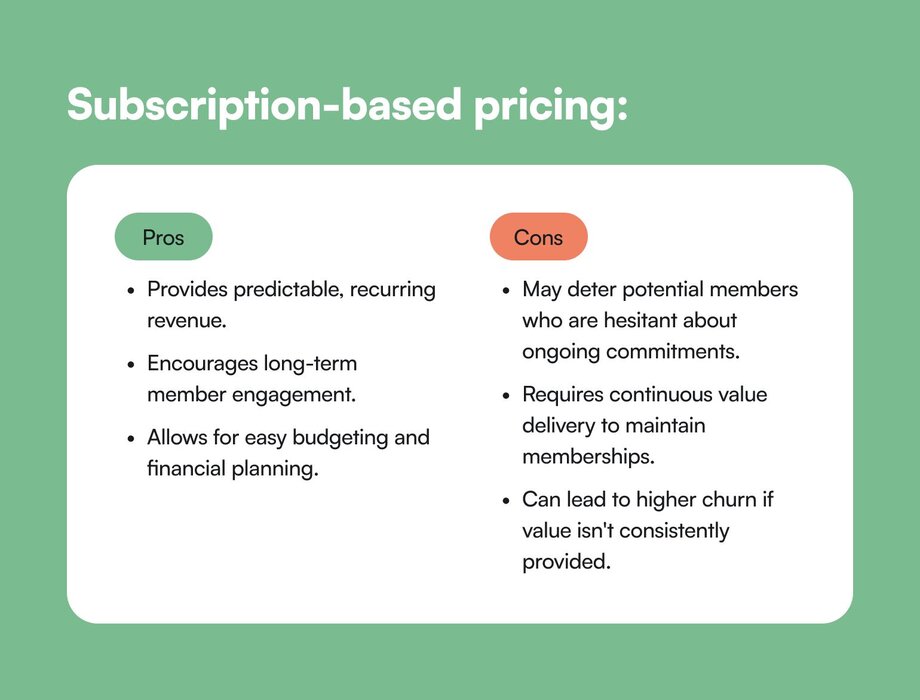
Implementation tips:
- Offer both monthly and annual plans, with a discount for annual commitment
- Consider implementing tiered pricing structures for different levels of access or benefits
- Regularly add new value to justify the ongoing subscription
Example: A professional development community might offer a basic tier for $29/month, a premium tier for $79/month with additional resources and coaching calls, and an elite tier for $199/month with one-on-one mentoring.
Pay-per-access model: flexibility and specialization
The pay-per-access model involves charging for specific events, content, or features within the community, rather than (or in addition to) an overall membership fee.
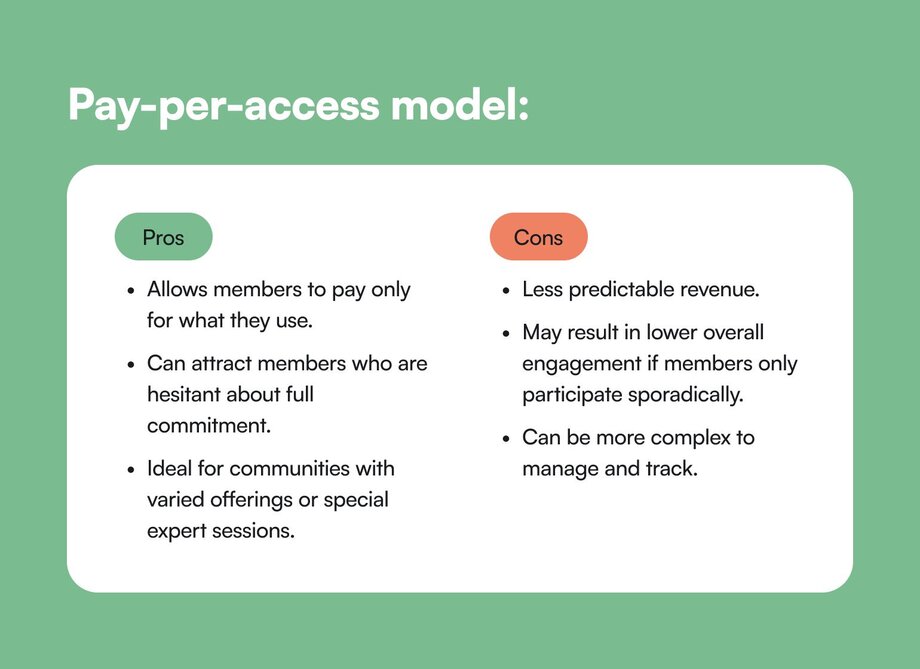
Implementation tips:
- Use this model for high-value, specialized content or events
- Consider combining with a basic subscription model for core community features
- Implement a credit or token system for easier management of multiple pay-per-access options
Example: A community for freelance writers might charge a base membership fee for forum access and job boards, but additional fees for writing workshops, pitch reviews, or one-on-one sessions with successful authors.
Value-based pricing: aligning price with perceived value
Value-based pricing involves setting your price based on the perceived value of your community to members, rather than on costs or competitor pricing.
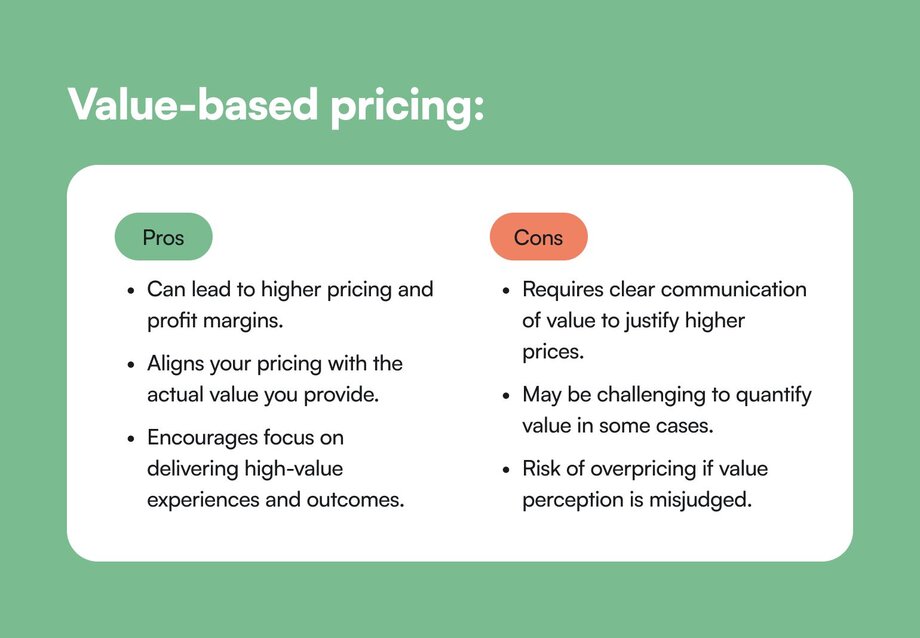
Implementation tips:
- Conduct thorough research to understand what your target audience values most
- Develop case studies and ROI calculations to demonstrate tangible value
- Continually gather feedback and testimonials to reinforce value perception
Jordan Godfey, another Circle expert, says “People don't pay for "stuff"–they pay for the tangible outcome and transformation they'll achieve.”
Example: A community for local business networking (like Whoggga) might charge a premium price ($350+/month) based on the potential value of connections, collaboration opportunities, and expert advice that could significantly impact a local business's success.
If you’re interested in diving deeper into understanding money mindset and pricing different types of communities (or prefer learning via video!) check out this community pricing masterclass.
How to set realistic revenue goals in 4 steps
Financial modeling can sound like a scary, advanced thing to those of us who weren’t born into a spreadsheet, but goodness is it helpful in feeling solid in your foundations, expectations, and dreams.
Here's a step-by-step approach:
- Determine your ideal community size: Consider your capacity to manage and provide value to members. Think about the dynamics you want in your community (e.g., intimacy vs. scale).
- Calculate required revenue: Factor in all costs: platform fees, content creation, marketing, your time, etc. Then, add your desired profit margin. 🤑
- Do the math: Divide your required revenue by your ideal member count to get a baseline price. Adjust based on other factors we've discussed (market positioning, value proposition, etc.)
- Create multiple scenarios: Model different pricing and member count combinations, including best-case, worst-case, and most likely scenarios.
Example calculation: Let's say you want to earn $100,000 annually from your community, with 500 members:
$100,000 / 500 members = $200 per member per year or $16.67 per month
This gives you a starting point, which you can then adjust based on other factors.
Avoid these common pricing pitfalls
As you develop your pricing strategy, be aware of these common pitfalls:
- Underpricing due to insecurity: Don't let self-doubt lead you to charge too little. Remember the value you're providing and price accordingly.
- Neglecting to increase prices over time: Plan regular price reviews and increases as you add more value, but grandfather existing members to maintain loyalty while increasing prices for new members.
- Arbitrary pricing: Avoid picking a price without proper research and strategy.
- Overcomplicating with tiers: While tiered pricing can be effective, don't go overboard. Keep your pricing structure simple and easy to understand.
- Ignoring competitor pricing: While you shouldn't simply copy competitors, being aware of their pricing as a benchmark (not a rule) is important.
- Failing to communicate value: Even the best pricing strategy fails if you can't articulate your value. Invest time in crafting clear, compelling messaging about your community's benefits–for example, ExitFive ensures to provide value on a monthly basis (at least) to make sure people feel like getting a bang for their buck.
Future-proof your community pricing strategy
Your pricing strategy isn't set in stone.
To achieve a sustainable business, you’ll want to conduct regular pricing reviews (e.g. every 6 months or so) to reflect on any changes like inflation, added features, and market changes. This will keep you flexible as your community or membership grows.
You’ll also need to create a regular cadence for gathering and acting on feedback from members–but that’s not just a pricing question. That’s a core component of your community strategy.
How do you stay informed about industry and market trends? Attend conferences, join meta-communities for community builders (for example, Circle’s customer community), and stay curious!
And always, always keep an “experiment-mentality”: look at emerging community models and pricing strategies, and use small experiments or beta groups to validate new approaches.
Pricing as a path to community success
"Charging appropriately allows you to sustainably serve members and run your community business long-term." - Tom Ross
Nailing your pricing strategy is not just about maximizing revenue—it's about creating a sustainable model that allows you to serve your members effectively while building a thriving community business.
So remember:
- Use a clear framework: Approach pricing systematically, considering all the factors we've discussed. This breeds confidence in your monetization strategy.
- Align price with value: Charge appropriately to sustainably serve members and run your community long-term. Your pricing should reflect the true value you provide.
- Validate and iterate: Test demand before launch by having founding members commit to specific tiers and price points. Continuously gather feedback and be willing to adjust.
- Communicate clearly: Your pricing strategy is only as good as your ability to articulate it. Invest time in crafting clear, compelling messaging about your community's value.
- Think long-term: Plan for growth and change. Regularly review and adjust your pricing strategy to maximize your community's potential over time.
- Balance accessibility and value: Find the sweet spot between making your community accessible and charging enough to deliver high-quality experiences.
- Learn from others, but chart your own path: While it's valuable to learn from other successful communities, remember that your community is unique. Tailor your approach to your specific circumstances and goals.
And if you’re looking for an all-in-one community platform that’s priced right on the money?
You’re in the right place.
Circle brings together your members, discussions, events, courses, and content—all in one place, under your own brand. Plus, you get access to our customer community full of handy resources and over 10,000 community builders on the same journey as you.